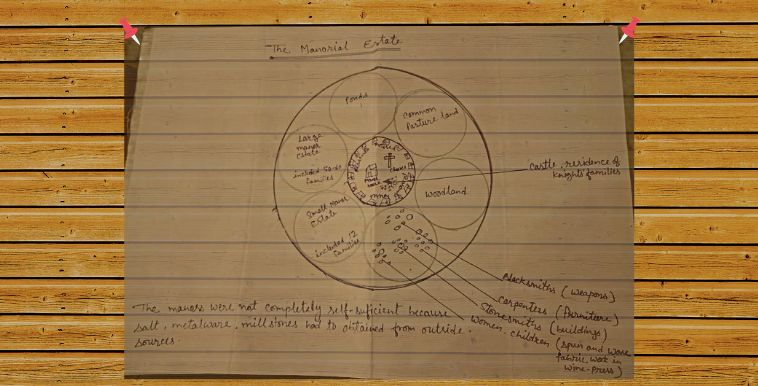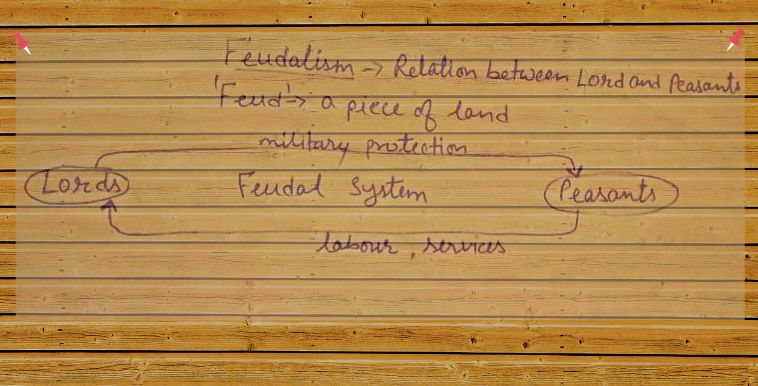This post is the precise notes of NCERT class 11 chapter 6 Part 1 Notes by Vibha Maam.
The Three Orders
Socio-economic and political changes between 9 to 16th century in Western Europe
Many groups of Germanic people occupied regions of Italy, Spain and France after the fall of the Roman Empire.
There were ‘three orders’ , three social categories:- Christian priest, landowning nobles and peasants.
Christianity was the official religion that’s why the church also became a major land holder and political power in Europe. There were lots of sources to understand that history:-
- Documents, details of land ownership, prices and legal cases
- The inscriptions in churches
- Songs and stories
Churches kept records of marriages, birth and death.
French scholar Marc Bloch worked on feudalism, and described French society between 900 and 1300 CE. it’s remarkable details of social relation and hierarchies, land management and culture in his book Feudal society.
An introduction of Feudalism
- Feudalism derived from the German word ‘feud’ which means a piece of land.
- Feudalism went beyond the economic to cover the social and political aspects of life as well.
- In an economic sense, feudalism is based on the relationship between lord and peasants, where peasants provided labour services for the lord in exchange lord provided military protection to the peasants.
- Peasants cultivated their own land as well as the lord’s land.
- Feudalism also existed during the reign of French king Charle magne (742-814)
France and England
- The Franks, a Germanic tribe, established their rule over ‘Gaul’ and renamed it France in the 6th century.
- The Franks were Christian and had strong relations with the pope in 800 c.
- The pope gave the title of ‘Holy Roman emperor’ to the King Charles Magne.
- The duke of French provinces of Normandy conquered England and Scotland in the 11th century.
The Three Orders
French priests believed in the concept that people could be divided in three categories according to the work, which were clergy, nobility, and peasantry.
The second order- The Nobility
Priests placed themselves in the first order and nobles in the second order because they controlled land and practiced ‘vassalage’.
- The kings of France were linked to the people by vassalage.
- The Nobel were vassals of the king and peasants were vassals of the nobles.
- The king was his ‘Seigneur ‘(senior) who would protect the vassals who would be loyal to him.
- The Nobles enjoyed a privileged status; he was the lord of all the people settled on his land.
Noble’s house called ‘manor’.
His manor contained his dwellings, his private fields and pastures and the homes and fields of his tenant peasants. Peasants cultivated their own land and nobles’ private lands and act as foot soldiers in the battle whenever required.
The Manorial Estate

The Knights
- The knights were sections of people who were good cavalry and trained soldiers.
- Knights were linked to the lords and kings as well.
- The lord gave them a piece of land (called fief) and promised to protect it .
- The fief could be inherited and extended to more than 2000 acres.
- The land of fief was cultivated by peasants and facilitated in feudal manor.
- In exchange for fief, the knight paid his lord a regular fee and promised to fight in war.
- In France, from the 12th century, minstrels travelled from manor to manor, singing songs which told stories of brave kings and knights. These travelling bards were very popular at that time.
The First Order – The Clergy
- The Catholic Church had its own laws.
- It did not depend on the king.
- The pope was the head of the Western Church, who lived in Rome.
- Bishops and Clerics were constituted ‘The First Order’.
- People were assembled every Sunday in the church to listen to the sermon by the priest and pray together.
- Serfs and women could not become priests.
- Bishops were the religious nobility who owned a vast estate like lords.
- Priest could not marry.
- The church levied tax (tithe), a tenth share of peasants’ produce.
Monks
Apart from the church, devout Christian chose to live isolated lives and lived in monasteries.
Two well-known monasteries were established by St. Benedict in Italy in 529 and Cluny in Burgundy in 910.
Monks took vows to remain in the abbey for their whole life and didn’t marry.
Unlike priesthood, this life was open to both men and women; Men became monks and women became nuns. There were separate abbeys for men and women.
Some groups of monks called friars, moved from place to place preaching to the people and lived on charity.
The Church and Society
- Christmas (Christ’s birth) and Easter (the crucifixion of Christ) became important dates from the 4th century.
- On this day, people of each village used to make a tour of their village lands (called Parish).
- Pilgrimage was an important part of the Christian’s life.
- People went on long journeys to shrines of martyrs or to big churches.
The Third Order- Peasants, Free and Unfree (Serfs)
The vast majority of the society were the cultivators.
They were of two kinds:- free peasants and unfree peasants (serfs)

Free peasants:-
- Tenant of the lord
- 40 days military service in a year
- Peasants’ families had to work for the lord’s Estate like weaving, wine-pressing, etc. It was called labour-rent.
- There was one direct tax called ‘taille’ imposed by kings only on peasants.
Serfs
- Cultivated lords plot
- Much of produce given to the lord
- No wages and no leave
- Lords permission required in his personal life
- Lords monopolis at the expense of his serfs.
Share this note with your friends and classmates and also comment in the comment section below.
Click here to read to Part 2 of this chapter.
For Novels and books at affordable price you can checkout Checkfirst











thanks mam, I appreciate your efforts and your dedication 🙏🏼
commendable job
awesome work
thanks maam you’re really doing a great work for us
ma’am part-2 kab upload karoge aap
part -1 is fabulous
happy Diwali mam
I’m waiting for part2